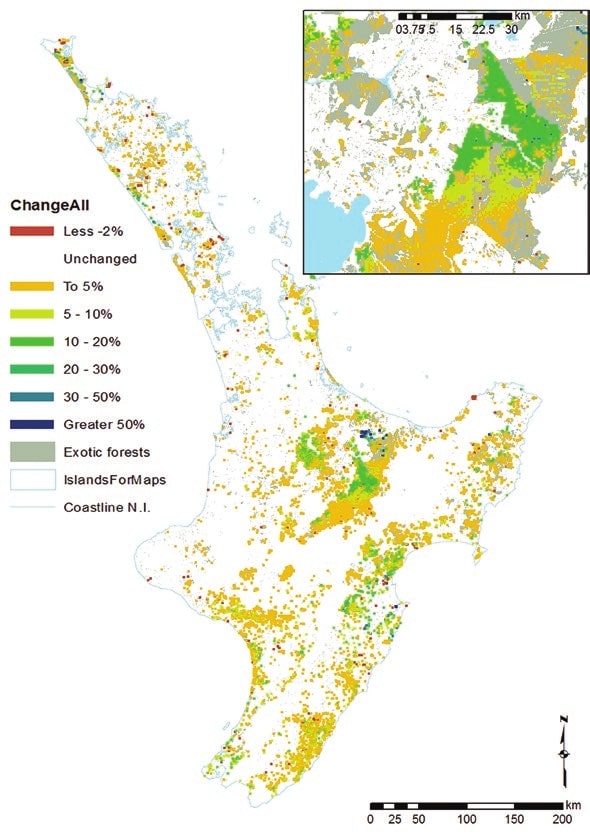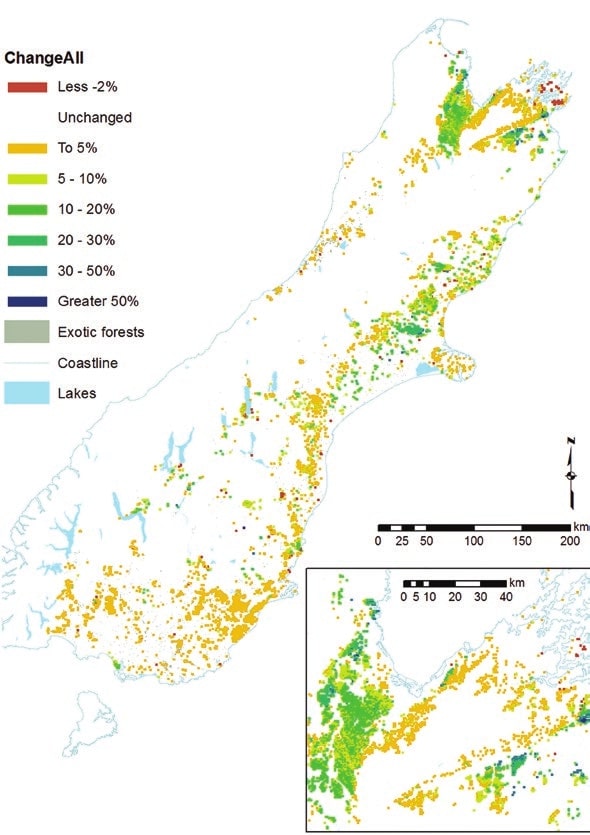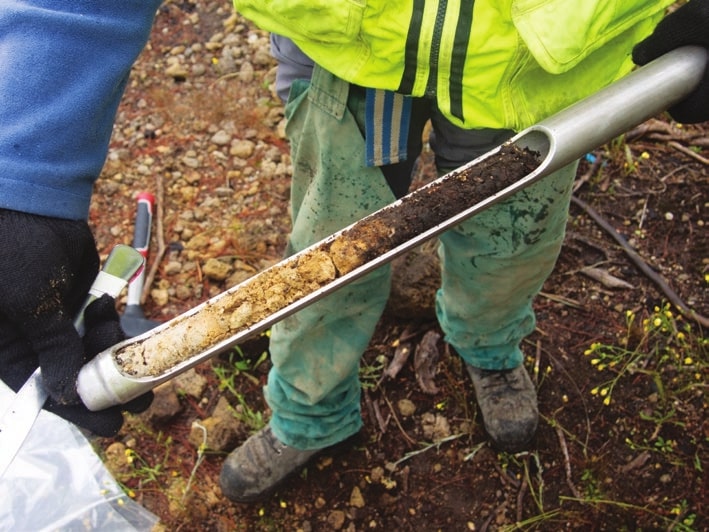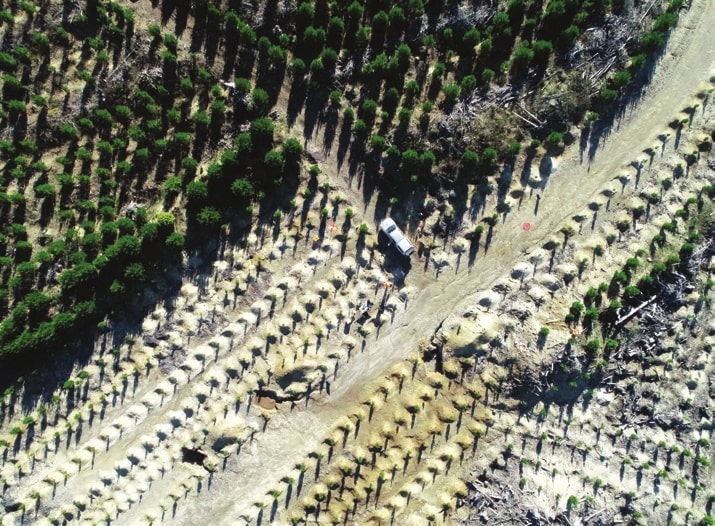How can I make my forest more productive and what does the latest research say?
Michelle Harnett, New Zealand Tree Grower August 2019.
Research. Some think it is essential, others think of it as a time-consuming, cash-devouring black hole. The people who have been working on the research programme Growing Confidence in Forestry’s Future, which started in 2013 and is finishing in September 2019, would argue that it is essential and their results will increase overall planted forest productivity.
Do I have a productivity gap?
Technically, forest productivity is the rate of biomass accumulation or volume shown as mean annual increment. According to The Forestry Roadmap for Aotearoa New Zealand 2020-2050, the forestry industry wants to double its productivity. This would need to see the mean annual increment in tree growth increase to about 40 cubic metres per hectare each year. The main factors which affect forest productivity are climate, soil, genetics and silviculture. One of these factors determines a forest’s potential productivity, another determines its current productivity. Identifying the current limiting factor allows owners of large and small forests and their managers to take steps to close the gap.
The first step to determining if you have a productivity gap is to work out what is going on in your forest. Previously, this might have meant using expensive field measurements to carry out a forest inventory as well as risking close encounters with some of our spikier weeds. However, as remote sensing techniques become cheaper and more accurate, they can be used to effectively estimate wood volume and the value of your woodlot.


Site Index and 300 Index
The two productivity indices most commonly used are the Site Index and 300 Index. The Site Index is calculated from tree height and age. The 300 Index is based on total stem volume. Both of these indices can be generated from aerial laser scanning data. Scion remote sensing scientists developed the methods by comparing the aerial data with field measurements from over 400 plots in the Kaingaroa forest. Then they validated their models using a further 60 plots. (For more on aerial laser scanner see Tree Grower May 2017).
The initial laser scanning work was carried out in 2014. The researchers commented that obtaining the laser data is expensive and that use of laser scanning is usually limited to local areas. In 2018, they looked at using satellite data instead. Several modern satellites can record stereo imagery which can be used to generate data showing the height of the imaged surface, such as the forest canopy. Using overlapping images of the forest canopy they were able to work out canopy height and calculate total recoverable volume, accurately predicting forestry inventory attributes for radiata pine forests on rugged terrain.
Generating a canopy height model from satellite data still needs access to digital land models, which are usually obtained using aerial laser scanning. However, only one scan is needed for satellite data. The Provincial Growth Fund is helping with increased scanning of the regions. The scanning is being managed by Land Information New Zealand. Waikato, Bay of Plenty, Hawke’s Bay, Tasman, Marlborough, Canterbury, West Coast and Southland are all on the list, and once the they are complete, over half the country’s land will have been scanned.
Cheaper and more often
Satellite data is cheaper than aerial laser scanning data, it is collected frequently and light from ultra violet to far red can be recorded. This information can be used to identify and map harvested areas, or monitor changes caused by disease, drought or soil deficiencies. For example, multispectral data collected by unmanned aerial vehicles and satellite imagery were able to detect stress in radiata pine which had been dosed with herbicide to mimic disease. The data from unmanned aerial vehicles was more sensitive and could detect stress down to the individual trees. The satellite data detected stress in clusters of four or more trees and could be very useful for observing trends in stress over larger areas.
The level of detail possible with aerial laser scanning means it can be an effective method of carrying out inventories on smaller forest lots. A number of companies offer aerial laser scanning services to interested land owners. Satellite data tends to be used for larger areas. Specialist companies also offer services based on satellite data to evaluate forests and plantations.
Climate as a limiting factor
Altering the climate just to grow trees is not practical, but choosing the right genetic stock for your conditions may be a possibility. Work in the Kaingaroa forest combining remote sensing, seedlot and climate found that the seedlots, along with spring and summer temperatures, were the most important factors in predicting the 300 Index, showing the importance of matching seedlot to site. This can be taken further by identifying individual trees with desirable characteristics growing in microclimates such as south facing slopes and using genetic material from these trees to identify the genes responsible for favourable characteristics and to breed for new improvements.
Soil fertility
Optimising nutrition over the period of a forest rotation by ensuring adequate nitrogen, phosphorus, carbon and other essential nutrients will allow trees to grow to their full potential on a particular site. The Nutrient Balance Model is a method which has been developed by Scion to calculate these demands and show when fertiliser addition could be used to increase productivity.
Fertiliser addition affects more than just tree growth. It also affects the microbes present in the environment and the way these interact with the trees. Nitrogen fertiliser has been seen to have a long-lasting effect on soil microbes, altering the distribution of these organisms. For example, altered microbiomes have been seen to enhance a tree’s tolerance to drought. Many forests in New Zealand are now into their second, third, even fourth rotation. Maintaining nutrients between rotations, especially on low nutrient sites, is important. Research has established the forest floor contains most of nutrients and that it is beneficial to leave about a third of the slash on the site.
Owners of small to medium forests can make sure they are getting the best out of their soil by understanding its limitations. Fertilising may be an option, but only if it is cost-effective. Work on alternative fertilisers and ways to get it where it is needed is continuing. Using harvesting practices which disturb the forest floor as little as possible, and leaving some slash on site, will help maintain soil fertility for the next rotation.
Genetic improvement
Selective breeding is very useful for improving growth rate, growth form and wood quality of radiata pine. The results from five decades of large-scale trials spanning New Zealand from Northland to Southland make it possible to predict the magnitude of gain for key traits when genetically improved trees are used.
Each increase in the GF Plus rating increases growth, straightness and wood density. The standing volume of trees grown from highly improved material GF Plus 25 was approximately 25 per cent greater compared with unimproved trees. This is equal to between 170 and 250 cubic metres a hectare at age 30, depending on site productivity, and opens up the possibility of shortening rotations to around 24 years. Improving wood density increases the recovery of high grade timber. For each unit increase in GF Plus the wood density index on average increased by 1.75 to 2.70 kilograms a cubic metre. Seedlots with GF Plus of more than 20 are also generally straighter than lower-rated ones.

Genetic improvement
The current level of average genetic improvement is estimated to have increased the present value of planted radiata pine forests by $3.5 billion, or $2,000 a hectare, compared with unimproved material. If all the plantation forests were further improved to the equivalent of a GF Plus 25 rating, the total increase in present value over unimproved material is estimated to be of the order of $8.5 billion, or just under $5,000 a hectare. Overall, the present value of the plantation forestry is predicted to increase by around half a billion dollars for each unit increase in the GF Plus rating.
Improving the genetics of radiata pine will continue to be a powerful lever to ramp up productivity while other factors which affect productivity, such as stand density and nutrition, are optimised. Over and above selection for growth, form and resistance to disease, research is showing that traits such as efficient water use, nitrogen uptake and interaction with the soil bacteria, fungi and other microbes can be also be selected. Forest owners and managers can look forward to matching seedlot to site choosing the right tree genetics for the right physical and biological environment.
Improved genetic material is available to anyone planning planting. The results from decades of research gives all forest owners and managers the confidence to invest in improved material.
Silviculture
Optimal stocking rates
Making sure you are growing the optimum number of trees is perhaps the simplest way to reach a site’s maximum productivity. Scion researchers have linked Site Index and 300 Index with environmental information to develop productivity maps for the whole country. They used the simulation system Forecaster to calculate the volume of S27 logs − large-diameter saw logs with small knots − which could be grown for various combinations of Site Index and 300 Index and stand density. From these simulations they were able to develop a model for optimum stocking levels.
The average predicted optimum stocking levels for growing S27 logs across New Zealand was found to be 614 stems a hectare. Given that the current average stand density for unpruned sawlog regimes is around 500 stems a hectare, there is definite scope for increasing the volume of high-value log products.
The figure of 614 stems a hectare is an average and site-specific recommendations can be made by taking account of local variations in productivity indices and the environment into account. Assessments at the end of a rotation of a large number of trials which were focused on the combined effects of seedlot and silviculture have looked at the effects of stand density, site and seedlot on yield, total value per hectare, relative value and wood properties. The results showed that stand density and site interacted and affected total value and relative value.
A lower stand density on a highly productive site increased relative value, possible due to fast canopy closure limiting the formation of large branches. A high stand density on less productive sites also led to an increase in relative value, possibly due to the higher stocking rate compensating for slower growth and slower canopy closure, and preventing branch formation.
This work suggests there is considerable scope for increasing plantation value across New Zealand by optimising stand density by site. Forest owners and managers can use the model to optimise stand density and maximise the value of their harvest.
Pulling the research together
Trial plots have been planted around the country to test the results of the Growing Confidence in Forestry’s Future programme. These accelerator trials are focusing on a range of issues which limit tree performance now and testing designs and strategies which foresters can adapt based on their own needs.
Sites in Kaingaroa forest and Tairua were planted in 2016, followed by planting on ex-grazing land at Rangipo near Turangi, and at Ashley forest near Christchurch and Tokoiti near Dunedin.
The accelerator trials are already producing results, especially around the importance of matching genetics to site. For example, trees with different genotypes interact differently with the soil microbiome and can shape the performance of a tree. Do some genotypes perform better on more fertile land and how could this change current could afforestation practices? Watch this space.

A productive future
The research programme has focused on how we can increase forest productivity, produce better quality wood and remain a sustainable industry. All forest owners and managers can use the results. Selecting healthy seedlings with the best genetics for their chosen site, fully stocking the site and ensuring an adequate nutrient supply will give an increased volume of higher value logs.
Advances in remote sensing to carry out accurate inventories may be especially helpful for owners of small to medium forests. They will be able to assess if their land could be more productive, they will also have a much clearer picture of their wood quality and be able to supply it to the right processors for right price. This should lead to lower supply chain costs and more of our wood resource being processed onshore. The assurance of a consistent wood supply in terms of quantity and quality will increase confidence of those considering investing in forestry and the processing sector.
Only some of the Growing Confidence in Forestry’s Future research has been touched on here. Other aspects include changes in nursery practices which reduce chemical use but produce stronger, more robust, seedlings, whether or not mid rotation fertiliser treatments can be effective and practical along with the effect of nutrients on wood formation.
Over the next five to 10 years the New Zealand forestry industry can look forward to greater productivity, increased planting and increasing investment in processing. Productive forests, with the right genotypes, on the right site, growing for the right purpose will benefit regional economies, the country as a whole and contribute the raw materials to build a sustainable future.
The Growing Confidence in Forestry’s Future programme was funded by MBIE and the Forest Growers Levy Trust.
Michelle Harnett is the science communicator for Scion.


 Farm Forestry New Zealand
Farm Forestry New Zealand